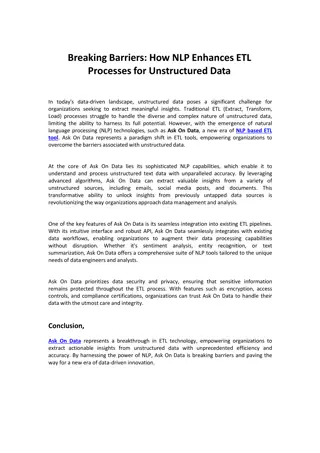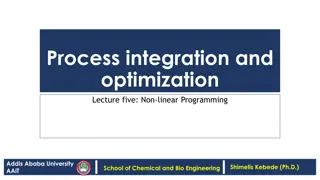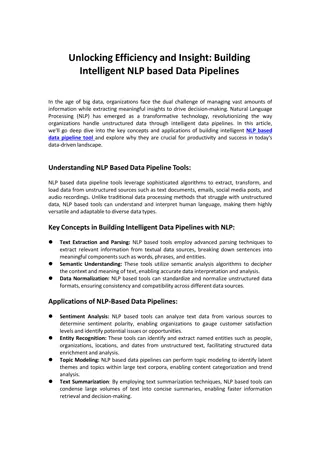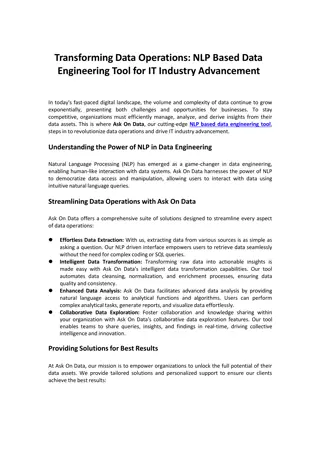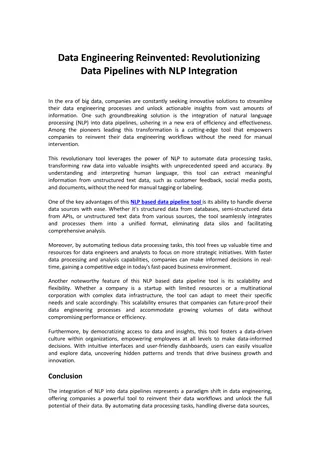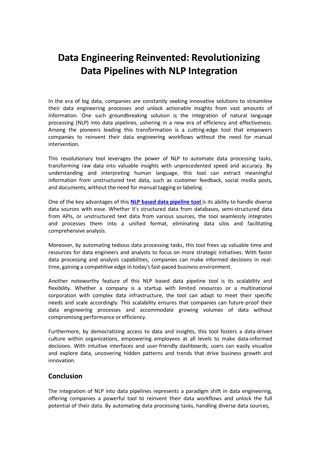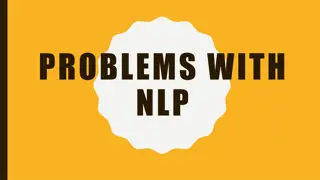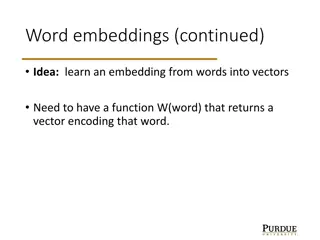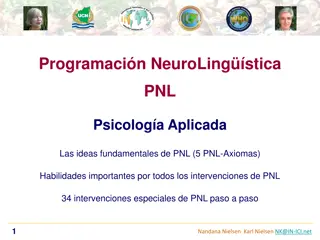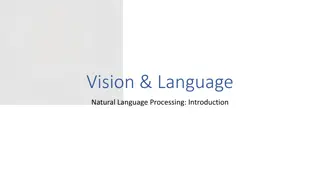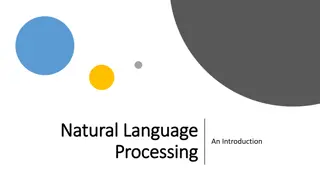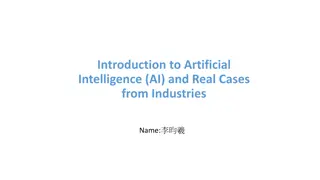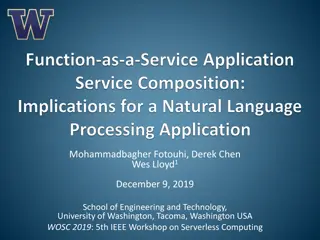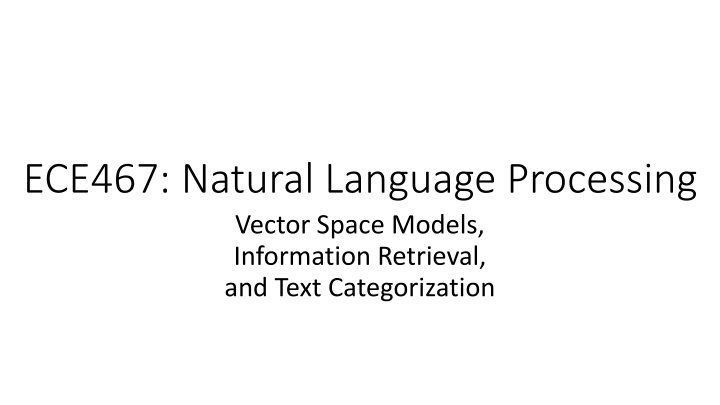
Vector Space Models and Information Retrieval in NLP
Explore the concepts of vector space models, information retrieval, and text categorization in natural language processing (NLP). Learn about the importance of information retrieval, conventional IR systems, and the role of text documents in responding to user queries. Discover how NLP techniques are used to retrieve relevant text documents and understand the challenges with conventional IR systems.
Download Presentation

Please find below an Image/Link to download the presentation.
The content on the website is provided AS IS for your information and personal use only. It may not be sold, licensed, or shared on other websites without obtaining consent from the author. If you encounter any issues during the download, it is possible that the publisher has removed the file from their server.
You are allowed to download the files provided on this website for personal or commercial use, subject to the condition that they are used lawfully. All files are the property of their respective owners.
The content on the website is provided AS IS for your information and personal use only. It may not be sold, licensed, or shared on other websites without obtaining consent from the author.
E N D
Presentation Transcript
ECE467: Natural Language Processing Vector Space Models, Information Retrieval, and Text Categorization
If you are following along in the book Part of this topic, on vector space models, is related to sections 6.3 through 6.5 of the current draft of the textbook Information retrieval is mentioned through various chapters, and is discussed in Section 23.1 of the current draft (the rest of the chapter is on question answering) Earlier versions and drafts of the textbook were weaker on the topic of information retrieval, in my opinion The na ve Bayes approach to text categorization is the subject of Chapter 4 of the textbook Other methods of text categorization are not discussed in the book (earlier versions of the textbook were also weak on this topic as well, in my opinion) Information retrieval and text categorization (especially the latter) are highly related to the work I personally did as a graduate student Therefore, I am only partially relying on the textbook, and largely relying on my own knowledge, for my slides on this topic
Information Retrieval Information retrieval (IR) is the task of returning, or retrieving, relevant documents in response to a particular natural language query A document in the context of IR can generally pertain to all manner of media, including text, photographs, audio, and video In this course, we are only concerned with the retrieval of text documents (or at least, documents that include text) Depending on the application, these text documents might be web pages, news articles, technical papers, encyclopedia entries, or smaller units such as paragraphs or sentences IR has been an extremely important application of NLP; I have noticed that some colleges offer entire courses on IR A collection refers to a set of documents being used to satisfy user requests A term refers to a lexical item (typically a word or token) that occurs in the collection A query represents the user's information need expressed as a set of terms
Conventional IR Many conventional IR systems assume that the meaning of a document resides solely in the set of terms (unigrams) that it contains Because such systems ignore syntactic (and arguably, semantic) information, these are often said to use bag-of-words approaches We will see that conventional text categorization methods also use bag-of- words approaches Some modern NLP methods involving word embeddings also make a bag- of-words assumption (if the ordering of embeddings is not considered) Some older, conventional IR systems allow Boolean queries; e.g., "information AND retrieval AND NOT vector" However, this approach has multiple short comings, and we will not discuss it further
Vector Space Models In the vector space model of IR, documents and queries are represented as vectors of features Each feature corresponds to one term (typically a word) that occurs in the collection The number of dimensions of each vector is equal to the size of the vocabulary The value of each feature is called the term weight The term weight is often a function of the term's frequency, possibly combined with other factors; we'll discuss this more soon Generally, we can represent a document, dj, as a vector, as follows: dj= (w1,j,w2,j,w3,j, ,wN,j) Above, N, the number of dimensions of the vector, is equal to the number of distinct terms that occur in the collection, and wi,jis the weight that term i is assigned in document j N can often be in the tens or hundreds of thousands Other text sequences, including queries, can be represented as vectors in the same manner However, most documents and most queries will not contain most of the possible terms that can occur (and hence, most of the feature weights will be zero); i.e., the vectors are sparse In practice, representations are used which do not require us to store all the zeros; we'll also discuss this more soon
Measuring Similarity Between Vectors The cosine similarity metric is often used in IR to measure the similarity between two vectors For example, the similarity between a query vector and a document vector from the collection can be measured as: i=1 N wi,q wi,j sim q,dj = i=1 2 i=1 N N 2 wi,q wi,j Another way to think of the cosine measure is as a normalized dot product; that is, it is equal to the dot product of the two feature vectors divided by their lengths I add: In practice, it makes more sense to normalize all the document vectors ahead of time I further add: You can optionally normalize the query vector for IR, but this may not be necessary if you are just interested in ranking documents based on similarities This characterization of documents, queries, and similarity provides the basis for an IR system The IR system accepts a user's query, creates a vector representation of it, compares it to the vectors representing all known documents, and sorts the results
Term-document Matrices We can also consider the entire collection to be represented as a sparse matrix of weights, where wi,jrepresents the weight of term i in document j This is known as a term-document matrix Here is a simple example of a small term-document matrix: Each column represents a document in the collection and each row represents a term
Inverted Indexes In practice, you do not store the entire matrix, since it is huge and sparse Rather, for each term, you store an inverted index The inverted index efficiently maps each term in the vocabulary to a list of documents, optionally including positions and/or weights An inverted index is often implemented as a hash table (the book calls it a dictionary) Including positions is important if you want the user to be able to search for exact phrases
TF*IDF Book (previous edition): "The method used to assign term weights in the document and query vectors has an enormous impact on the effectiveness of a retrieval system." Using term frequency (TF) as one component of the term weight reflects the intuition that terms that occur frequently within a document should have higher weight However, words that are frequent in general ("the", "of", etc.) should not have high weights Therefore, a second commonly used component of term weight is often used so that higher weights are assigned to words that occur in fewer documents; these terms tend to be more discriminating The inverse document frequency (IDF) term weight is defined as: idfi= log10 N dfi Here, N is the total number of documents in the collection and dfi, the term's document frequency, is the number of documents in the collection in which term i occurs Combining TF and IDF leads to the common scheme known as TF*IDF weighting (our textbook denotes this as tf-idf, and I have seen other formats used as well): wi,j=tfi,j*idfi With this weighting scheme, the highest weights are assigned to words that are frequent in the current document but rare throughout the collection as a whole The book also discusses one alternative weighting scheme, called BM25, that they call "a slightly more powerful variant" of TF*IDF; we will not discuss this Book (previous edition): "With some minor variations, this tf-idf weighting scheme is used to assign term weights to documents in nearly all vector-space-retrieval models."; this is no longer true, but it is worth noting how dominant TF*IDF used to be in NLP
A TF*IDF-based IR System Using TF*IDF weights and only iterating over the words with non-zero weight, we obtain: w q,dtfw,q tfw,d (idfw)2 sim q,d = qi q(tfqi,q idfqi)2 di d(tfdi,d idfdi)2 Note that the summation in the numerator only needs to loop through words in the query (and there are generally very few) The denominator normalizes the vectors As before, assuming that documents in the collection have been pre-normalized and we only care about rankings, the denominator can be left out In practice, given a query, an IR system using the vector space model can proceed as follows: Loop through the terms in the query For each term, use an inverted index to find all documents containing the term Add to the similarity score of each document that contains each query word At the end, sort the documents based on their similarities to the query
Other Issues As with other NLP applications, we need to decide whether an IR system should apply stemming (common), apply lemmatization (not common), convert all letters to the same case, etc. We need to be consistent with the text normalization techniques applied to the collection Many conventional IR systems also use stop lists, containing stop words, which are just lists of very common words to exclude from the computation This doesn't change results much, since these words tend to have very low IDF values; it could make the system more efficient, but makes it more difficult to search for phrases Another technique used to by some conventional IR systems is to add synonyms of query terms to the queries to help locate documents that are relevant but don't use overlapping terms The vector space model is not the only way to implement a conventional IR system; another approach (more common for earlier IR systems) was to use a Bayesian model We will consider a Bayesian approach for text categorization, in addition to an approach using a vector space model, and also a k-nearest neighbors (KNN) approach Another important issue is how to evaluate the performance of IR systems, but we will mostly skip this We will later discuss how to evaluate text categorization systems, which uses some of the same metrics (but text categorization doesn't share all the issues that make evaluation of IR more difficult)
Ranking Web Pages I add: Another issue not discussed in the textbook is ranking algorithms that are specific to web search (e.g., how Google ranks its results) Such ranking could just be based on similarity metrics (e.g., the cosine metric to compare TF*IDF vectors) Historically, early web retrieval search engines did this, but they could easily be fooled Some websites, for example, put invisible, popular search terms in their pages to fool search engines Popular web search engines today treat the web as a directed graph; intuitively, good pages will tend to be more popular and have more incoming directed links pointing to them The Hyperlinked-Induced Topic Search (HITS) algorithm involves authorities (pages that have a lot of incoming links from other good pages) and hubs (pages that point to a lot of authorities) Given a query, the algorithm first determines an initial set of web pages that are relevant to the query, and then uses an iterative approach to determine authorities and hubs
PageRank Google's PageRank algorithm also rates pages based on links, but the algorithm is not query- dependent (and therefore it is more efficient than HITS) PageRank uses the following formula: PR pi=1 d Here, PR(p) is the PageRank of p, N is the total number of pages in the corpus, pjare the pages that link to pi, and c(pj) is the count of the out-links on pj; d is a damping factor To explain this, the textbook that I use for my AI course (previous edition) asks readers to imagine a web surfer starting at a random page With probability d, they click on one of the links on their current page arbitrarily; with probability 1-d, they get bored and move to any random page on the web PR(p) is related to the probability that the surfer will be at page p at any point in time Since PageRank uses a recursive formula, computing it involves an iterative procedure; the algorithm starts assigning PR(p) = 1 to every page, and it iterates until convergence Early versions of PageRank could still be fooled by islands of web pages that linked to each other, but later versions can detect such islands and give them low scores PR(pj) C(pj) N+ d pj
Text Categorization Text categorization (TC) is the automatic labeling of documents based on text contained in, or associated with, the documents into one or more predefined categories, a.k.a. classes Some sources use the term text classification to refer to this task; however, that term is also commonly used in a more general sense to include TC, IR, and sometimes clustering Some TC tasks assume that the categories are independent, i.e., binary or Boolean Each document can then be assigned to zero, one, or multiple categories; most of the conventional NLP literature on TC deals with such categories Other TC tasks assume mutually exclusive and exhaustive categories; each document is then assigned to exactly one category (the best fit) If a task involves exactly two mutually exclusive and exhaustive categories (e.g., Indoor vs. Outdoor), you can alternatively view the task as involving one binary category One special case of TC involves categories that form a hierarchy or taxonomy; a conventional example was the Yahoo! directory of web pages (which eventually became defunct) Some researchers have found benefit using a ladder approach for this sort of categorization; each individual decision is simpler, but there are more stages at which an error might occur
Applications of Text Categorization Some (of the many) applications of text categorization include: Classification of e-mail as spam or not spam (a.k.a. ham), i.e., spam filtering Classification of news into topical sections (e.g., Google News, Columbia Newsblaster) Websites as pornography or not pornography Reviews as positive or negative (a type of sentiment classification, which can also apply to tweets or news reports, and may involve more fine-grained categories) Automatic grading of essays (actually used by ETS) One interesting early application of text categorization was authorship attribution Mostellar and Wallace (1964) examined a subset of the Federalist Papers There was a historical dispute about whether the author was James Madison or Alexander Hamilton Using techniques that were very different than modern techniques (involving words such as "of" and "upon"), they definitively concluded that Madison was the author
Conventional TC Approaches As with information retrieval, many conventional TC approaches rely on a bag-of-words approach to represent documents Some approaches use a vector space model Some TC tasks that use alternative, task-specific approaches or representations; for example, authorship attribution typically uses very few words, and essay grading looks at other features of documents Most conventional TC systems use single words (unigrams) as terms; larger N-grams typically did not improve results Different weighting schemes are possible for vector space models; for several TC strategies, TF*IDF weights were the most common in conventional TC systems relying on vector space models We will cover three conventional TC approaches; namely, Rocchio/TF*IDF, k-nearest neighbors, and na ve Bayes; only na ve Bayes is discussed in our textbook Other conventional approaches that have been applied to TC include decision trees, support vector machines, and conventional neural networks More recently, deep learning approaches involving word embeddings have been applied to TC, but mostly for tasks involving short sequences of text (e.g., tweets and individual sentences) We will learn about deep learning approaches for TC during the third part of our course
Text Normalization for TC As with IR, you must decide what constitutes a term (i.e., what tokenization and other text normalization strategies are used) Some specific issues that TC shares in common with IR include: Whether or not to make the system case sensitive (capitalization could indicate a proper noun or the start of a sentence) Whether or not to use stemming (e.g., Porter stemming) or lemmatization Whether or not to use a stop list Whether to apply POS tagging (there are at least two potential ways that this could be used) Most conventional TC approaches that rely on a vector space model normalize document vectors; some also normalize category vectors
Machine Learning for TC Almost all TC systems use supervised machine learning techniques; the training data is in the form of labeled documents If the categories are binary, you need positive and negative examples for each category If the categories are mutually exclusive and exhaustive, you need examples of each category One advantage of machine learning (ML) for TC is that it is general To move to a new set of categories, we only need a new training set Sometimes it is possible to create or obtain a training set without manually labeling any documents, but often this is not the case You may need to recruit volunteers to label documents Creating a proper training set is often the most expensive part of creating a TC system, but resources like Amazon Mechanical Turk can make it simpler Some issues: How large should the training set be? How should labels be collected? How many volunteers will label each document? What level of agreement should be required? Etc. Once a TC system is trained, most text categorization approaches can be applied to new documents one at a time; sometimes this is necessary (e.g., for spam filtering)
Rocchio/TF*IDF The Rocchio/TF*IDF approach stems from Rocchio's approach to relevance feedback, which was historically important for some IR systems The approach uses a vector space model to represent not only documents but also categories Each category is represented by the sum of the documents that belong to the category; generally, these category vectors are normalized Each category vector can be thought of as a centroid for the category Assuming mutually exclusive and exhaustive categories, then for each document, this method chooses the category with the highest similarity to the document: c = argmax sim c,d c C Similarity can be computed according to the cosine metric, as discussed in relation to IR However, if category vectors are normalized, a simple dot product is guaranteed to return the same result, since cos( ?, ?) = ? ? ? ?, and ? does not vary between categories Some Rocchio/TF*IDF systems also include a vector based on all non-instances of each category from the training set and subtract a lower-weighted similarity to this centroid (we will not discuss the details)
Rocchio/TF*IDF with Binary Categories The Rocchio method for TC is more complicated when dealing with independent, binary categories The system needs to convert similarity scores to YES/NO decisions There are at least three possible methods of doing this: The SCUT method calculates an optimal cutoff for each category based on the training data The PCUT method computes the percentage of training documents in each category and assigns the same percentage of test documents to category Using the PCUT method requires access to the entire test set at once A third method (I am not aware of a name for it) creates a second category for each real category consisting of all documents not in category This third method then decides, for each category, if the document is more similar to the actual category vector or to the non-category vector The Rocchio/TF*IDF method is specifically intended for text categorization; the next two TC approaches we discuss are more general ML approaches
K-Nearest Neighbors The k k- -nearest neighbors nearest neighbors(KNN) approach is an example of instance-based learning (a.k.a. example-based learning, memory-based learning, or lazy learning) Training simply consists of recording which training instances belong to each category When a new document arrive, it is compared to those in training set Assuming documents are represented as numerical vectors, the "closeness" of one document N(wx,i wx,j)2 to another can be measured according to Euclidean distance: D(di,dj)= x=1 Once all distances are computed, you find the k closest documents from the training set The value of k can be manually coded or chosen based on cross-validation experiments or a tuning set The categories of these k nearest neighbors will be used to select the category or categories of the new document As described, this method is general, not just for text categorization
Choosing a Category with KNN If the categories are mutually exclusive and exhaustive, the system can simply choose the most common category among the k closest documents If the categories are binary, the simplest approach is to choose all categories that are assigned to over half of the k closest documents Better is to weight each of the k documents inversely proportional to its i=1 Idi,c D d,di+ i=1 D d,di+ In the formula, Idi,cis 1 if dibelongs to c, 0 and otherwise; is a small constant to avoid division by 0 1 k distance: Sim(d,c) = 1 k
KNN Applied to TC For conventional text categorization, the document vectors would often be TF*IDF vectors, as with the Rocchio/TF*IDF approach The KNN approach has performed very well in the literature for conventional text categorization, although I saw mixed (mostly poor) results in my own work I often found that it is often better to use similarity (e.g., cosine similarity) instead of distance to find and weight the k-nearest neighbors Documents can then be weighted proportional to their similarity instead of inversely proportional to their distance Training for KNN is trivial and fast, but that is not too important, because training only needs to be performed once To classify a document, however, it must be compared with every document in the training set Efficiency is a major problem with KNN; it is generally considered to be computationally intensive To combat this, there have been some efforts to find approximate nearest neighbors more efficiently; this may be significantly faster with only a small decrease in accuracy
Nave Bayes The na ve Bayes approach to categorization is a probabilistic approach based on Bayes' theorem (which we previously encountered when discussing POS tagging with an HMM): P d c P(c) = argmax c C c = argmax P c d = argmax [P d c P c ] P(d) c C c C The argmax above assumes that categories are mutually exclusive and exhaustive We eliminated the denominator, P(d), because it is independent of the categories P(c) is just the prior probability of a category This can be estimated based on the training set as the frequency of training documents falling into the category, c We still must estimate P(d|c) It is typically assumed that d can be represented as a set of features with values We start with the "na ve" assumption that the probability distribution for each feature in a document given its category is not affected by the other features Note that na ve Bayes, as described so far, is a general approach, not just for TC
Nave Bayes Applied to TC Na ve Bayes for text categorization is still considered a bag-of-words approach, but it does not use a vector space model, and it does not rely on TF*IDF word weights (or any word weights) The features are the words of the vocabulary, and they are typically considered Boolean features In other words, all that matters is whether each word does or does not appear in the document The "na ve" assumption for TC is that the probability of seeing a word in a document given its specific category is not affected by the other words in the document Note that this is clearly not true in reality, but Na ve Bayes can still perform well for TC The standard technique is to estimate, based on the training set, the probability of seeing each possible term (or word), t, in each possible category, c; we will call this P(t|c) This leads to: P d c = t d P(t|c) The probability estimates are small, so we use log probabilities instead of probabilities, leading to the predicted category (assuming categories are mutually exclusive), c, for a document, d, being: log P(t|c) c = argmax logP c + c C t d
Implementation Details of Nave Bayes for TC As previously mentioned, P(c) can be estimated based on the training set as the frequency of training documents falling into the category, c P(t|c) is typically estimated as the percentage of training documents of category c that contain the term t; in other words, this is a maximum likelihood estimate, which we discussed in previous topics P(t|c) = # training documents in category c that contain word t / # training documents in category c Note that the formula for P(t|c) in the textbook is different; I have found that it does not work as well When looping through the terms in the document to categorize, you can either loop through distinct terms or all term instances Looping through all term instances gives more weight to words that appear multiple times However, a paper by Ken Church shows that the probability of a word appearing twice in a document is closer to p/2 than p2 Smoothing is very important to avoid 0 probabilities when using na ve Bayes (we briefly discussed smoothing techniques during our topic on N-grams) Na ve Bayes can achieve very good results for many sets of for TC with various categories and other tasks However, the final probabilities, which can be computed for each category, are not generally accurate (probably because the na ve assumption is not true)
Evaluating TC Systems Evaluating a TC system is generally easier than for IR, because there is typically a labeled test set Overall accuracy is often a reasonable metric for mutually exclusive and exhaustive categories However, this is not reliable for binary categories; most documents will generally not belong to most categories, so a trivial system that says no to everything might appear to do very well This was true of the most common conventional TC corpus, the Reuter's corpus; it includes 9,603 training documents and 3,299 test documents; there are 135 "economic subject categories" Therefore, for each category, it is common to measure precision, recall, and a metric called F1 (or the more general F-measure) These metrics can be used for categorization in general, not just TC Consider a confusion matrix (which is a type of contingency table) where rows represent a system's predictions, and the columns represent the actual categorizations of documents The next slide shows a generic example of such a confusion matrix for a single binary category We will define all the metrics mentioned above in relation to such a confusion matrix (formulas are shown on the next page)
TC Evaluation Metrics (per category) Consider the following confusion matrix for a single binary category: Actual=Yes Actual=No Prediction=Yes A B Prediction=No C D We can define: Overall accuracy = (A + D) / (A + B + C + D); this is the fraction of predictions related to this category that were correct Precision = A / (A + B); of the documents that were predicted to belong to this category, this is the fraction of them are actually do belong to the category Recall = A / (A + C); of the documents in the collection that actually belong to this category, this is the fraction of them were predicted to belong to the category F1 = (2 * Precision * Recall) / (Precision + Recall); this combines precision and recall into a single metric, in between precision and recall, closer to the lower of the two We can define these metrics similarly for mutually exclusive and exhaustive categories (the confusion matrix would have a row and column for each category)
TC Evaluation Metrics (per system) When there are multiple binary categories, it is useful to compute metrics that evaluate the system as a whole Two ways to combine the category-specific metrics are micro-averaging and macro-averaging To compute the micro-averages for the first three metrics, you combine all the confusion matrices (for all categories) to obtain global counts for A, B, C, and D You then apply the formulas from the previous slide to compute the micro-averaged overall accuracy, precision, and recall The formula for F1 remains the same and is based on the micro-averaged values of precision and recall To compute macro-averages for the first three metrics, you average together the values of overall accuracy, precision, or recall for the individual categories The formula for F1 remains the same and is based on the macro-averaged values of precision and recall Micro-averaging weighs each decision equally; macro-averaging weighs each category equally
Publication Bias In my own research, I found that different methods performed well for different TC tasks and datasets This sometime surprised me, not always matching what I expected due to publications at the time Generally speaking, almost every published academic paper that describes a machine learning approach applied to some task (not just TC) reports positive results The related notion of publication bias may indicate that the literature gives us an exaggerated notion of the goodness of at least some of these methods The two main reasons for publication bias are: Reviewers reviewing submissions for conferences or journals are more likely to accept those reporting positive results compared to those reporting negative results Researchers who obtain positive results are more likely to attempt to publish their work compared to those who obtain negative results If multiple researchers test the same method applied to some particular task, some may obtain positive results by chance; those that do are much more likely to have their results published This is not to suggest that anyone is doing something wrong intentionally, or that results were wrong due to an unintentional mistake (although either of these things might happen at times) Personally, I think publication bias may be a big problem, not only in the field of machine learning, and it isn t clear what can be done about it
No Free Lunch In general, the fact that different machine learning methods work well for different tasks should not be surprising In fact, no representation can be efficient for representing all possible functions The number of distinct functions that can possibly represent a domain with a specified number of attributes is generally huge Here is an example discussed in the textbook I use for my AI course: Consider Boolean functions on n Boolean attributes: There are 2npossible combinations of inputs; each can lead to a positive or negative output This leads to 22?possibilities (i.e., possible combination of outputs) 6 Boolean attributes lead to 226= 18,446,744,073,709,551,616 different functions to choose from (and that s a really big number) More generally, the no free lunch theorem (sometimes pluralized) tells us that no machine learning methodology is good for all possible ML tasks
Properties of Categories There are many factors to consider that can affect which methods perform the best for a particular text categorization task First, we will consider some properties of the categories (most of these are not specific to TC): Are they mutually exclusive and exhaustive or independent, binary categories? Are they general or specific categories? Related to the last question, do the documents within a category vary a lot, or do they tend to be very similar to each other? Are they topic-based categories? Are they action oriented? Do they involve sentiment? Are they abstract? Are there many categories or few? Are some categories significantly more likely than others (i.e., do some categories contain a relatively high or low percentage of documents)?
Properties of Data Next, we will consider some properties of the data (some of these are specific to TC): Are the documents short or long? How big is the training set (i.e., how many documents are in it)? Is the training set likely to be very representative of the documents to which the system will be applied later? Are the training labels accurate or is there a high degree of error? (This could depend on how the training data is collected) Is there any missing data? (This is not generally an issue with TC, but it is an issue that some machine learning methods handle better than others) Is there additional metadata (text or otherwise) associated with documents? Properties of the categories and data may very well affect which ML, and specifically TC, methods perform well for a given task Especially considering the No Free Lunch theorem, we have no reason to assume that one method will perform the best for all tasks

